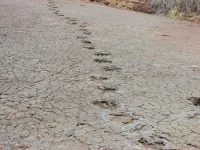(Press-News.org) Despite increased funding for cataract surgeries to private, for-profit clinics, access to surgery fell 9% for lower-income people, according to new research published in CMAJ (Canadian Medical Association Journal) https://www.cmaj.ca/lookup/doi/10.1503/cmaj.240414.
“Unexpectedly, despite new public funding for operations provided in private for-profit surgical centres, which was intended to fully cover all overhead costs and remove the need to charge patients, this disparity did not decrease, but instead grew during the funding change period,” says lead author Dr. Robert Campbell, a clinician–scientist in the Department of Ophthalmology at Queen's University and a senior adjunct scientist at ICES.
The COVID-19 pandemic created backlogs for cataract surgery and, to increase access without the need for patients to pay, the provincial government provided funding to private clinics in 2020.
The study, conducted by researchers at ICES, Queen’s University, and the University of Toronto, included 935 729 cataract surgeries performed in Ontario between January 2017 and March 2022. Researchers looked at differences in socioeconomic status of patients who underwent surgery at publicly funded hospitals and patients who accessed surgery at private, for-profit centres before the additional funding (up to February 2020) and after (March 2020–2022).
The majority of cataract surgeries (81%) were performed in public hospitals, with the remaining 19% performed in private, for-profit surgical centres. Over the 6-year study period, more people in the highest socioeconomic bracket (23%) received surgery in private clinics than patients in the lowest income bracket (14%). In-hospital surgeries were evenly distributed across socioeconomic brackets. Cataract surgeries in private, for-profit centres increased from 16% in the prepandemic period to 23% in the period after the funding increase. Surgical rates in private, for-profit centres rose 22% for patients in the highest socioeconomic bracket, but rates fell 9% for patients in the lowest socioeconomic group.
To improve access for patients across all socioeconomic levels, policy changes are needed to ensure transparency and a lack of conflicts of interest.
“Patient protection requires the removal of all conflicts of interest among surgeons, including centre ownership and incentive plans aimed at promoting the sale of add-on services. Patients need clear, non-conflicted information regarding the availability of publicly funded options without additional fees within both public and private for-profit centres,” write the authors.
They suggest creating a single wait-list for all private surgical clinics and public hospitals in an area, rather than separate lists for public hospitals and for-profit centres.
“Addressing the factors underlying this incongruity is vital to ensure equitable access to surgery and maintain public confidence in the cataract surgery system.”
END
People of lower socioeconomic status less likely to receive cataract surgery in private clinics
2024-08-26
ELSE PRESS RELEASES FROM THIS DATE:
Tick-borne Powassan virus in a child
2024-08-26
With tick-borne viruses such as Powassan virus increasing in Canada, clinicians should consider these infections in patients with encephalitis, as a case study shows in CMAJ (Canadian Medical Association Journal) https://www.cmaj.ca/lookup/doi/10.1503/cmaj.240227.
Although rare, Powassan virus is serious, with a death rate of 10%–15% in people with encephalitis, and it can cause lingering health effects after infection. The virus can transmit within 15 minutes of tick attachment, and symptoms can develop 1–5 weeks later.
In this case study, a 9-year-old child with up-to-date vaccinations ...
Survey finds more than 3 in 4 Americans don’t feel they could help someone suffering an opioid overdose
2024-08-26
EMBARGOED UNTIL 12:01 A.M. AUGUST 26, 2024
NOTE TO EDITOR: (To download broadcast-quality video and other multimedia elements: https://bit.ly/3M2ljhX (password: naloxone)
COLUMBUS, Ohio – International Overdose Awareness Day is a worldwide campaign held each Aug. 31 that acknowledges the grief of family and friends left behind from those who have died from a drug overdose. This year’s campaign theme “Together we can” highlights the power of the community standing together to help end overdose.
However, a new survey of 1,000 Americans from The Ohio State University Wexner Medical ...
How to control your screentime use and make technology work for you
2024-08-26
Many of us feel that we, or our children, spend too much time staring at a screen. From gaming to social media use or ‘doomscrolling,’ it can sometimes feel that we are mindlessly spending hours going down a rabbit hole of technology.
However, according to Catherine Knibbs, a psychotherapist who specializes in cybertrauma and online harms, there are tangible steps we can all take to wrestle back control from the hands of the technology corporations.
In her new book, Managing Your Gaming and Social ...
Matching dinosaur footprints found on opposite sides of the Atlantic Ocean
2024-08-25
DALLAS (SMU) – An international team of researchers led by SMU paleontologist Louis L. Jacobs has found matching sets of Early Cretaceous dinosaur footprints on what are now two different continents.
More than 260 footprints were discovered in Brazil and in Cameroon, showing where land-dwelling dinosaurs were last able to freely cross between South America and Africa millions of years ago before the two continents split apart.
“We determined that in terms of age, these footprints were similar,” Jacobs said. “In their geological and plate ...
Turning bacteria into bioplastic factories
2024-08-23
In a world overrun by petroleum-based plastics, scientists are searching for alternatives that are more sustainable, more biodegradable and far less toxic to the environment.
Two new studies by biologists at Washington University in St. Louis highlight one potential source of game-changing materials: purple bacteria that, with a little encouragement, can act like microscopic factories for bioplastics.
A study led by graduate student Eric Conners found that two relatively obscure species of purple bacteria have the ability to produce polyhydroxyalkanoates (PHAs), natural ...
Researcher finds sound progress in babies’ speech development
2024-08-23
The sounds babies make in their first year of life may be less random than previously believed, according to a language development researcher from The University of Texas at Dallas.
Dr. Pumpki Lei Su, an assistant professor of speech, language, and hearing in the School of Behavioral and Brain Sciences, is co-lead author on two recent articles in which researchers examined the sounds babies make. The results suggest that children in their first year are more active than previously thought in their acquisition of speech.
“We observed in these studies that infant vocalizations are not produced randomly; they form a pattern, producing three categories of sounds in clusters,” ...
Two epicenters led to Japan’s violent Noto earthquake on New Year's Day
2024-08-23
Key takeaways
The 7.5- magnitude earthquake beneath Japan’s Noto Peninsula on Jan. 1, 2024, occurred when a “dual-initiation mechanism” applied enough energy from two different locations to break through a fault barrier – an area that locks two sides of a fault in place and absorbs the energy of fault movement, slowing it down or stopping it altogether.
An international team of researchers led by UCLA graduate student Liuwei Xu, professor Lingsen Meng and UC Santa Barbara’s Chen Ji analyzed a preceding seismic swarm and identified a previously unknown barrier in the region of the swarm.
The team’s data collection methods could ...
A leaky sink: Carbon emissions from forest soil will likely grow with rising temperatures
2024-08-23
Photos
The soils of northern forests are key reservoirs that help keep the carbon dioxide that trees inhale and use for photosynthesis from making it back into the atmosphere.
But a unique experiment led by Peter Reich of the University of Michigan is showing that, on a warming planet, more carbon is escaping the soil than is being added by plants.
"This is not good news because it suggests that, as the world warms, soils are going to give back some of their carbon to the atmosphere," said Reich, director of the Institute for Global Change ...
Rice bioengineers develop lotus leaf-inspired system to advance study of cancer cell clusters
2024-08-23
HOUSTON – (Aug. 23, 2024) – The lotus leaf is a pioneer of self-cleaning, water-repellant engineering. Water droplets all but hover on its surface, whose unique texture traps air in its nanosized ridges and folds.
Rice University bioengineers report harnessing the lotus effect to develop a system for culturing cancer cell clusters that can shed light on hard-to-study tumor properties. The new zinc oxide-based culturing surface mimics the lotus leaf surface structure, providing a highly tunable platform for the high-throughput generation of three-dimensional nanoscale tumor models.
The superhydrophobic array device (SHArD) designed by Rice bioengineer Michael King and ...
To mask or not to mask: That is still the question
2024-08-23
CHICAGO --- Despite the association between mask mandates/mask wearing and reduced death rates during the pandemic, masking remains controversial and highly politicized, with many people still asking, “do masks work, and should they be recommended?”
In an editorial about the use of surgical face masks in public, published today, Aug. 23, in The BMJ, Northwestern Medicine internal medicine experts Drs. Jeffrey Linder and Rachel Amdur make the case for masking but acknowledge it’s not a cut-and-dried topic.
The ...



